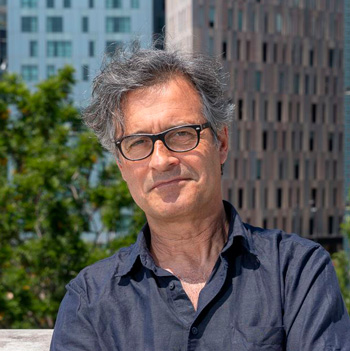Sergi Jordà
4. Kaleidoscope
Lullabyte: The engineering of sleep and dreams
Sergi Jordà (shown in the picture), Perfecto Herrera 1 and Tinke van Buijtene2 Music Technology Group (MTG), Department of Information and Communication Technologies (DTIC), UPF
Sleeping is an essential activity, and not just for humans. Most beings experience sleep, a vital biological need that we share even with insects and other invertebrates. This universal process, common to the biological diversity of living beings, establishes a deep link between us all and highlights the intrinsic connection between sleep and life itself. All animals sleep and some even seem to dream.
Despite spending nearly a third of our lives sleeping, we know amazingly little about this activity. It is surprising how unknowledgeable we are about how sleep influences our daily lives, or what we can do to improve our relationship with this fundamental aspect of our existence. The science of sleep, or somnology, dates back only to the second half of the 20th century and deals with the study of all aspects of sleep: biological mechanisms, environmental factors and the related psychological aspects.
This broad perspective also involves multiple techniques and subjects of study, from the physiology of sleep to the mental processes that take place during the different stages of the sleep cycle. In this regard, it is possible to distinguish two distinct sleep states (rapid eye movement, or REM, sleep and non-REM sleep), which seem to have clearly different functions and manifestations. Dreams occur in the REM phase, during which our body remains virtually motionless. In contrast, physiological repair and homeostatic restoration, as well as the consolidation of learning done whilst awake, take place during non-REM sleep. Notwithstanding some certainties about each stage, many mysteries remain to be solved.
This lack of knowledge may explain why we so readily sacrifice sleep for fun, socializing or work. We are insufficiently cognizant of the importance of good sleep and good dreams. The practical applications of somnology, such as improving sleep quality or cognitive functions, such as memory, reducing stress, facilitating physiological regeneration and homeostasis, improving people’s quality of life, and developing sleep regulation devices are the subject of sleep and dream engineering.
The connections between sleep and music are diverse. Perhaps the most obvious is the possibility of inducing sleep with lullabies, which are found in many cultures. In adults, this type of induction is also widely used, with a variety of techniques, technologies and (often, ‘personalized’) sound stimuli. However, other potential connections between music and sleep have yet to be clarified. This is what the European doctoral network Lullabyte, made up of ten European universities, aims to do. Lullabyte brings together, for the first time, specialists from disciplines as diverse as musicology, psychology, neuroscience, musical technology, data science and artificial intelligence to formalize the effects and possibilities of music and sound and explore them in greater depth. The ultimate goal is to help people fall asleep faster and sleep better once they do, given the benefits of better sleep for cognition, the immune system, the metabolism and mood.
Our research at UPF focuses on the real-time analysis of brain waves detected by means of (minimally intrusive) light-weight headphones. The aim is to intervene in the deep-sleep (non-REM) phase with synchronized sound signals that can help lengthen this phase or enhance sleep quality over its course. In other words, we investigate the possibilities of a closed-loop system between brain waves and sound waves to induce or maintain the deep-sleep phase or achieve longer or better-quality sleep. We also analyse how this can benefit memory, learning or mood.
Although we know that the brain is highly unlikely to respond to many external stimuli during the deep-sleep stage, there is evidence that some processing of sound information still occurs, as different types of sounds generate different patterns of electrical activity in the sleeping brain. How ‘deeply’ can a piece of music be detected or understood? How can we present musical stimuli without waking the subjects up? Do simple sounds have the same effects as noises? Are some times during the non-REM sleep phase better than others for sound stimulation? And, once we learn more efficient ways to use this stimulation, if sounds and music can indeed be used to carry out positive interventions, how can we make them more effective? These are some of the questions the Lullabyte team at UPF asks. Nor do we rule out the possibility that this new knowledge will enable the creation of simple ‘sound’ devices to help us not only fall asleep more easily, but also have deeper and more restorative dreams.
The study of sleep and ways of intervening in it are not without dangers and unavoidable moral considerations, however well-intended the research might be. As Jonathan Crary, author of the book 24/7: Late Capitalism and the Ends of Sleep, explains: ‘There are now very few significant interludes of human existence (with the colossal exception of sleep) that have not been penetrated and taken over as work time, consumption time, or marketing time [...]. Sleep is an uncompromising interruption of the theft of time from us by capitalism.’
We want to think and work in order to better protect sleep from the onslaughts that Crary warns of through the new knowledge generated by research. Only once we have an intellectual grasp of what good sleep entails will we have the physical and moral strength to fiercely protect this preserve that has, since the dawn of human kind, been so ‘sacred’.
1 MTG and the Catalan School of Music (ESMUC).
2 Doctoral student.

